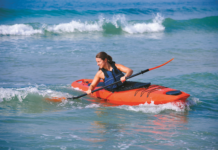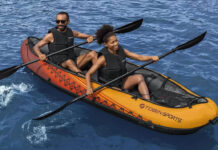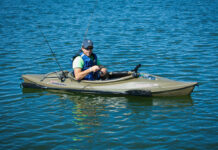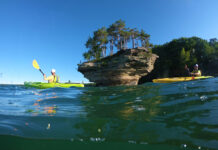It’s funny how time changes perspective. A year ago, Liquidlogic’s shiny hulls and Lego colours were new and different, simple and seemingly at the time, unfinished. We felt like we were paddling a prototype. With familiarity comes acceptance, and with the amount of yellow and blue on the river it seems paddlers are embracing the Liquidlogic Skip and Pop kayaks with open arms.
Liquidlogic Skip / Pop Specs
Length: 6’4” / 6’6”
Width: 23.5” / 24.25”
Rocker: 7” / 8”
Volume: 39 / 50 U.S. gal
Weight: 29 / 32 lbs
Weight Range: 100-160 / 160-220 lbs
MSRP: $1,500 CAD
Liquidlogic’s Skip and Pop arrive in style
Liquidlogic started with the same spin surface used in the slicier Session and Session Plus, but the basic premise behind the hull design of the Skip and the Pop was to get air. Once they had a boat they figured would hop, they added back in cartwheelability and comfort.
Designer Shane Benedict separates air into three different types: hole air, wavewheel air and wave air. Hole air is used for moves like loops or space Godzillas. These moves happen by trapping volume underwater quickly, forcing the boat to explode back to the surface and catch air. Wavewheel air is more just keeping the boat on the surface paddling downstream over waves and drops and then being able to easily throw it around. Finally, wave air is for moves like ollies (hops) or blunts—air you can achieve from the surface of a wave.
Emphasis was put on making the boat perform best on faster waves. Liquidlogic feels this was achieved by paying close attention to the rocker geometry of the boat. Shane explains: “Rocker allows the boat to rock from the bow to the flat surface easily. If you wanted a good analogy you could say that having a slightly curving rocker through the ends of the boat is like having small skate ramps attached to the front and back of your boat. If the skate ramp is just straight from flat ground to 45 degrees it is very rough and hard to control, but if the ramp has a smooth curving transition from flat to 45 degrees it is much easier to control and carry speed into the move or jump.”
Outfitting requires some work to customize
It’s as if Liquidlogic focused on the performance of the hull and left the outfitting for paddlers to tweak and play with. There is plenty of room in the Skip and Pop for your butt and feet but not quite enough room for our testers’ knees. The back band is ratcheted into the thighbraces and the front pillar pulls out to insert the one-piece foam foot block. There is little shape to the thigh braces, potentially creating pressure points and bruising. The seat and thigh braces do move forward and back but require separate tools to make the adjustment.
The Liquidlogic Skip and Pop come with a bare bones outfitting rig by today’s multi-adjust standards; designer Shane Benedict’s confirms, “We added the normal outfit kit and foam foot blocks because we found that most people still did their own custom outfitting. We weren’t going to rush into an outfitting system that everyone is just going to tear out and rebuild with normal foam anyway.”
Designers can do many things with plastic, but length of waterline equals speed. Short boats like the Skip and Pop, with their extreme rocker, are slow. But what does it mean to the average river runner? You have to paddle like mad everywhere you go.
Beginner and intermediate paddlers were frustrated with the lack of river running performance. River paddlers said the Skip and Pop paddled like a Kleenex box. We’d never heard that one before, but apparently a Kleenex box doesn’t hold a line, slides sideways, and its square side-walls catch every little current. The high sidewalls made it difficult to roll and paddlers kept smashing their elbows on them. Luckily for these paddlers, Kleenex boxes are full of tissues. There are tough choices to be made when designing and buying boats. Liquidlogic didn’t design the Skip and Pop to be river running boats, they were made to play.
Skip through the water and Pop in the air
With most spud boats you trade sliceability for wave bounce. Not so with the Skip and Pop; they are one of the most vertically slicey and stable short boat designs. The volume drops away from the cockpit like in traditional hole boats allowing the ends to slice cleanly underneath. Flatwater initiation and stalls are a breeze and put these boats in a small pourover and you’re in for piles of fun. However, it took some of our intermediate testers a few tries to get used to being further down in the trough when initiating the bow. And because the ends are so short and slicey, you have to be lightening fast to stay ahead of it. As the holes got bigger true cartwheels became more just tumbling forward toward the trough. Difficult to score but balls of fun.
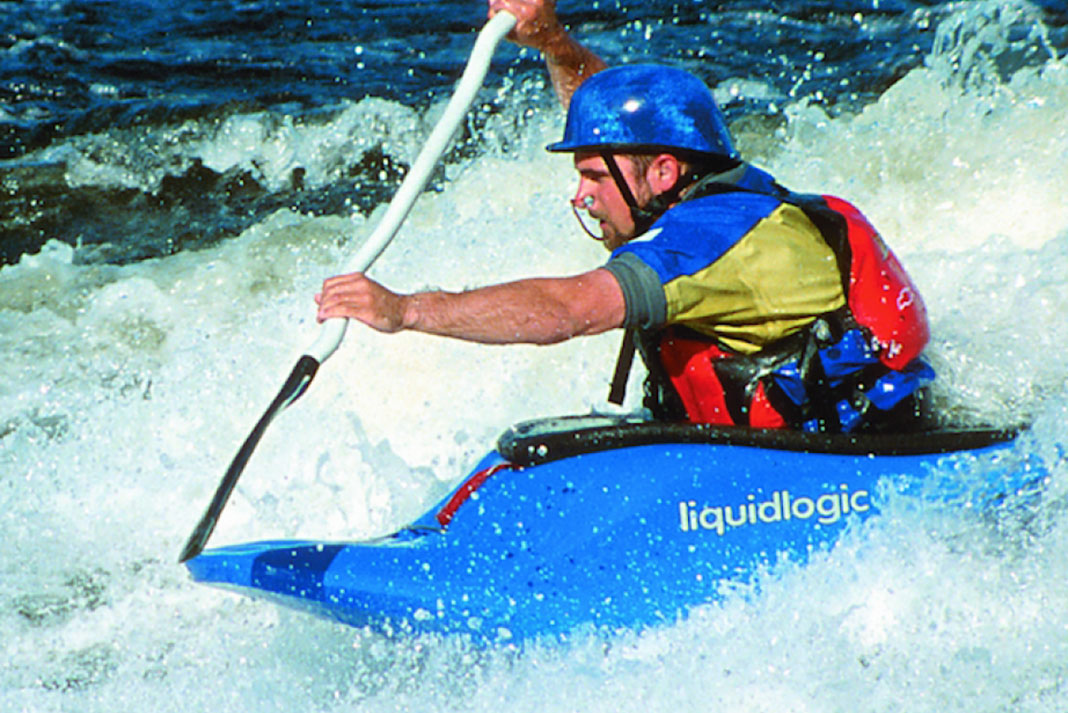
If surfing and spinning is more your cup of tea, there are definitely fewer waves in the world if you are paddling the Skip or Pop. Slower, green waves are just not accessible in these boats. Get them on something a little steeper or with a bit of a foam pile and they wake up into carving machines.
The Skip and Pop want to be surfed off the front edge just behind the rocker break, so get forward in an aggressive paddling position. One tester said it surfs like a watermelon seed—a quick lift of your knee and you are sharply squirting (like a seed, not a squirt boat) across the wave setting up for spectacular blunts. They are so short and the rocker so extreme you effortlessly roll up on the bow or stern and come around so quickly it is difficult to judge if you’re vertical. You quickly learn to use the edges and put less effort into every move.
Our reviewers were not seasoned pilots on the aerial frontier. We can’t tell you if they bounce better than other spud boats, and we’re not entirely sure if the pros have figured it out yet either. We can tell you that in a couple weeks in the Skip and Pop we figured out loops, bouncing, aerial blunts and are playing around with the rest. These boats are super light and learning the moves is as easy as bobbing your hips for some bounce and then just huckin’ your body in the direction you want to go—we’re still working on the timing.
Play your way with the Liquidlogic Skip and Pop kayaks
To say the Skip and Pop are boats for advanced paddlers isn’t really true; what is true is that they are boats designed for paddlers wanting to play. And they are one of the few designs that excel in a hole, on a wave and in the air.
Our moaning about Liquidlogic’s outfitting hasn’t seemed to bother owners of either a Skip or Pop. They’ve simply padded their knees and built themselves a solid fit out of foam.
With so few paddlers taking advantage of the aerial capabilities of these new boats we can’t help but wonder if Liquidlogic will let the Skip and Pop ride for another year while skills catch up to the boats.
This article was first published in the Summer 2002 issue of Rapid Magazine. Subscribe to Paddling Magazine’s print and digital editions, or browse the archives.



